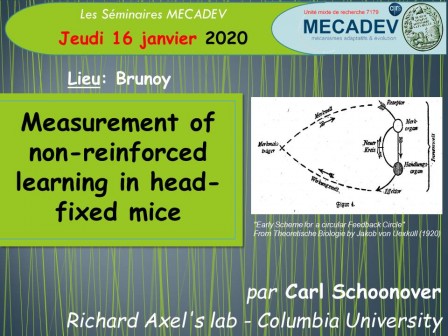Lieu: Brunoy
Title: Classical
results in experimental psychology (Blodgett/Tolman, Sokolov, Brogden,
Groves/Thompson, Berlyne) have documented that animals continuously learn
complex features in their sensory environment. This faculty does not depend on
external reinforcement to drive learning, only the existence of structure in
the world. We seek to understand how an organism forms a model of the world’s
statistics when the vast majority of the time it is neither rewarded nor
punished for doing so.To this end we have recently developed a behavioral
paradigm for the head-fixed mouse that permits observation of exploration and
non-reinforced learning. The Virtual Burrow Assay simulates a scenario in which
a mouse, poised at the threshold of its burrow, evaluates whether to exit the
enclosure or to retreat inside in response to a potential threat. The device
consists of an enclosure (virtual burrow) constrained to slide back and forth
along the anterior-posterior axis of the body of head-fixed mice, and measures
their propensity to exit and explore versus retreat to safety. By simulating
the contingencies at the threshold of the burrow the assay exploits innate
behaviors of the mouse thereby circumventing the need for training. The assay
yields a sensitive readout of habituation, discrimination and exploration, as
well as avoidance of both conditioned and innately aversive cues. It is
compatible with standard electrophysiological and optical methods for
measurement and perturbation of neuronal activity; its millisecond-timescale
record of behavior permits precise alignment of neural state to behavioral
state.
DOI: 10.7554/eLife.45658
Assay
design and software: git.io/JvenJ
